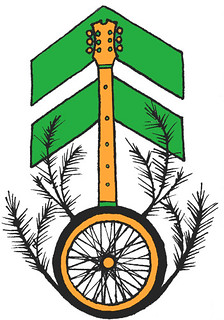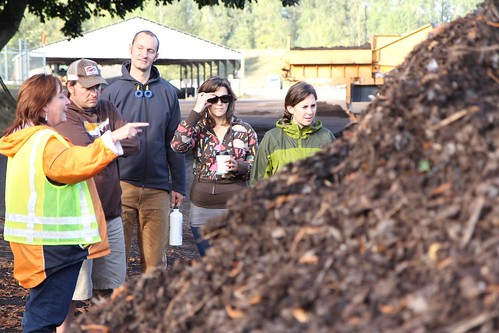Tag: PBOT
It’s Pedalpalooza time!

What better way to start the summer than by cycling with friends and neighbors along a family-friendly path that connects neighborhoods with city lakes and natural areas? This June 9 Pedalpalooza event wraps up with a community potluck picnic and live bluegrass at Columbia Park (N Lombard and N Woolsey).
The adventure begins at 2:00 pm at Pittman Addition HydroPark, N Concord and N Going, along the Concord Neighborhood Greenway in the Overlook neighborhood. The path covers just over 11 miles along Neighborhood Greenways and through natural areas at Smith and Bybee lakes. It will take about three hours, including stops along the way to learn about some of the fun projects and partnerships that make Portland’s neighborhoods unique and green. Aside from a three-block hill at the start and a gradual incline from the Columbia River, the path is flat and easy for both kids and adults.
From leaves to compost – and beyond
Ever wonder what happens to the leaves you haul to depots or rake into the street for a city of Portland pickup (if you live in a Leaf Zone)?

On a sunny fall day, Portland Bureau of Transportation’s Jill Jacobsen gave Friends of Trees staff a tour of the Sunderland Recycling Facility and what remained of the compost made from last fall’s leaf harvest. Last year Sunderland received 11,505 cubic yards of leaves and made nearly 4,000 cubic yards of compost.
Median trees on Powell Blvd. in question

Since 2007 local and state transportation agencies have wrangled with the canopy complications surrounding planned improvements of Powell Blvd., also known as U.S. 26.
There are a little over $1M in improvements planned—including enhanced pedestrian and bike crossings at key intersections—but only about $400,000 worth have been approved and funded.
A collective uproar could be heard from the Southeast Uplift Neighborhood Coalition (SEUL) after a meeting in April when local business owners proposed using the planned improvements as an opportunity to remove all of the median trees on the road from SE 50th to 82nd.
A spokesperson for the Oregon Department of Transportation (ODOT) said that median trees and sidewalks fall under the maintenance jurisdiction of the Portland Bureau of Transportation (PBOT).
“ODOT supports what the community and the city want to do with the median,” said Mike Mason, community affairs coordinator with ODOT.
“ODOT removed 12 trees to build ADA compliant curb ramps and new crosswalks,” said Mason, “These will be replaced with 47 new trees in the project area.”
The project area, where the new Americans with Disabilities Act compliant sidewalks will be installed, is between SE 51st and I-205.
There are dozens of substantial median trees along Powell Blvd., most of which are in large concrete planters that can grow long grass that is difficult for PBOT to cut back.
Regardless, the SEUL emphatically rejected the notion of removing all median trees as a part of any U.S. 26 improvement plant.
“There is clearly strong support from the community for keeping trees,” acknowledged Ginny Peckinpaugh, who works on transportation issues at the mayor’s office.
Unmaintained, tall grass is also an issue, but Peckinpaugh said any further plans will only be implemented after further community discourse and if additional stimulus funds become available.
Have you driven down Powell Blvd. lately—what do you think of this issue? Are the trees and grasses a hindrance or worth protecting?
Additional information on the Powell Blvd. Streetscape Plan from ODOT and PBOT.
–Toshio Suzuki
Neighborhood Greenways means Neighborhood Trees

A new exclusive interview published today on BikePortland.org explains one of the main reasons why the Portland Bureau of Transportation (PBOT) changed the name Bike Boulevards to Neighborhood Greenways: trees.
Excerpts from the article:
The main reason for the change is to better reflect what these projects are all about. PBOT realizes that by calling them “bike boulevards,” some Portlanders instantly bristle and come to project open houses armed for battle against them. PBOT hopes the new name won’t elicit such a negative reaction to the non-biking public.
This conversation, according to PBOT traffic safety staffer Greg Raisman, will move PBOT from merely talking about transportation to a more concerted focus on “placemaking and community building.” One way to do that is by making more green spaces on our streets. Raisman says PBOT is working with Friends of Trees to place new street trees along entire routes of new neighborhood greenway projects. On one project in the works, there’s an idea to extend a park completely across the existing street (NE Holman) and maintain a cut-through only for bikes.
In addition to this exciting discussion, street tree policy in Portland is taking shape in accordance with the Citywide Tree Project (CTP) and the Portland Plan, too.
What do we think of combining bike traffic and street trees?
–Toshio Suzuki
From “tree cheers” to an East Burnside renovation

This blog posed an earlier question, “if a tree is cut down in the City, and nobody asks why, did it really happen?” The answer is an emphatic yes—and that particular tree was debated, considered, and permitted for removal under the watchful eye of Portland Parks & Recreation (PP&R) Urban Forestry.
The stump featured on East Burnside Street was a permitted removal as part of the Burnside-Couch Couplet project. This $17.8 million project will transform Burnside and Couch—from East 14th Avenue to West 24th Place—into one-ways, adding traffic signals, bike lanes, trees, stormwater treatment swales, curb extensions, and more.
The goal is to make this busy traffic corridor more pleasant and functional for pedestrians, bicyclists, drivers and businesses. This Portland Bureau of Transportation (PBOT) project has been in the works for 10 years, and has been reviewed by City Council, the Urban Forestry Commission, and many other stakeholder groups.
Portland Urban Forestry has a dedicated Tree Inspector who works with PBOT to ensure that trees are considered during all aspects of construction and development, and that proper permits are obtained.
